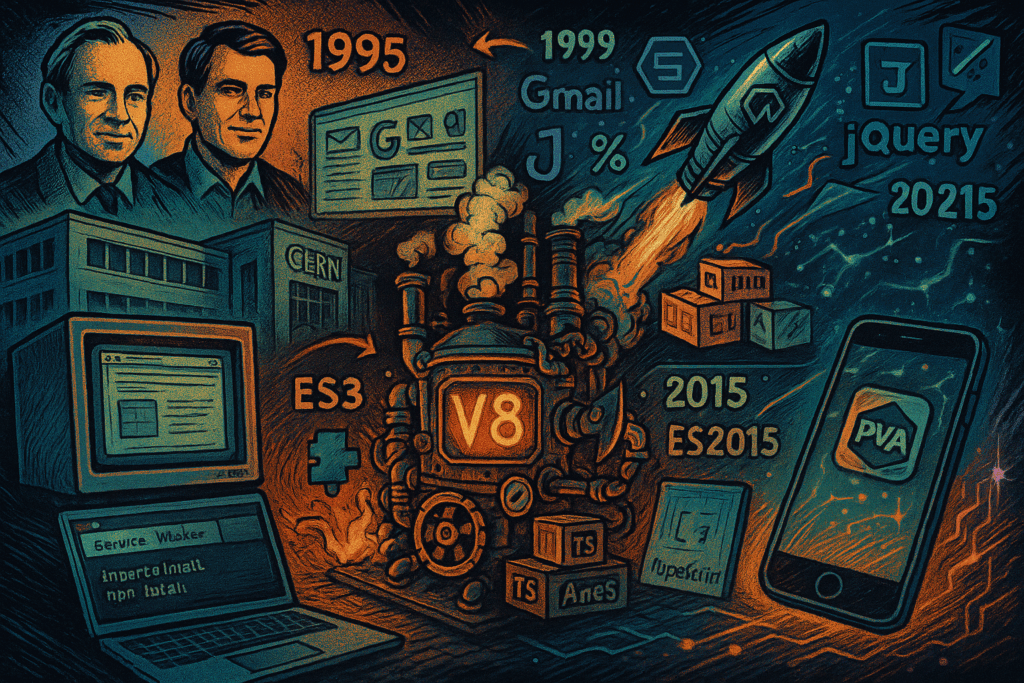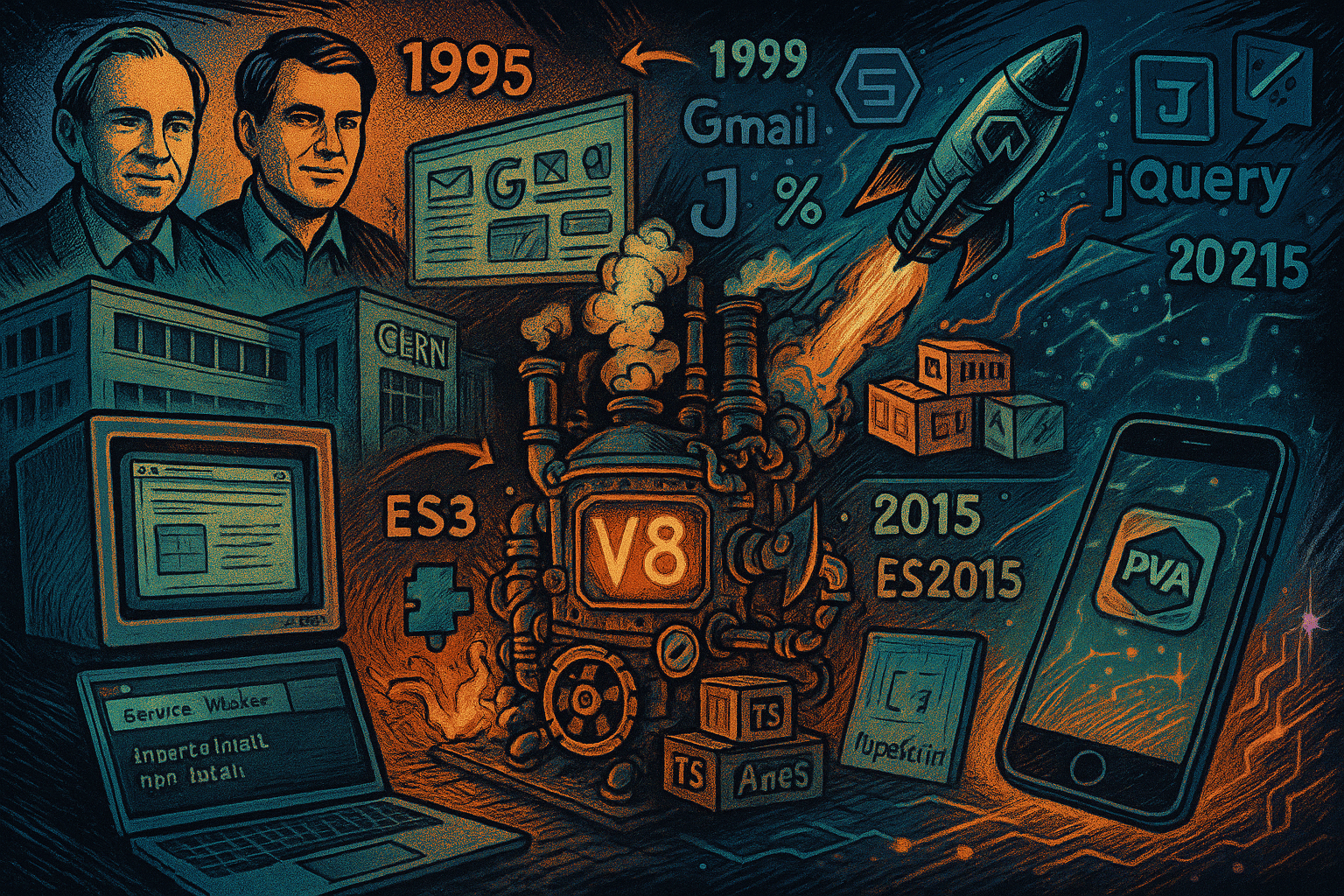Javascript from Joke to Joy to Juggernaut in 30 Years
TL;DR – Standards + easy sharing.
Here’s the short version of how JavaScript went from “toy” to a first-class platform, and who/what made it happen.
1995–2004: A scrappy beginning → standards
- Birth (1995): Brendan Eich built the first version at Netscape in ~10 days. It was called Mocha → LiveScript → JavaScript; Sun & Netscape announced it that December. Standardization moved to Ecma and the first ECMA-262 spec shipped in 1997. (Wikipedia)
- Early specs: ES3 (1999) added try/catch, regexps, etc. Then a long lull and a failed attempt at a big ES4 rewrite (abandoned in 2008), which led to the “Harmony” reset and a focus on incremental evolution. (Wikipedia, ADTmag, johnresig.com)
- AJAX era (2004–05): Microsoft’s earlier XMLHttpRequest (IE5, 1999) became the backbone of “AJAX,” popularized by Gmail (2004) and Google Maps (2005). This proved web apps could be fast and interactive without page reloads. jQuery (2006) then smoothed browser quirks for a generation of developers. (Wikipedia, jquery.org)
2008–2012: The engine arms race (speed made JS serious)
- Google Chrome + V8 (2008): Google launched Chrome with the V8 JIT engine, focusing on raw performance (hidden classes, inline caches, etc.). Other browsers countered with TraceMonkey (Firefox), SquirrelFish/Nitro (Safari), and later IonMonkey (Firefox). This era made complex JS apps actually feasible. (Chromium Blog, Brendan Eich)
- Node.js (2009) + npm (2009/2010): Ryan Dahl took V8 to the server; Isaac Schlueter created npm. JS suddenly spanned client and server, and a package ecosystem exploded. (Wikipedia, RisingStack Blog, WIRED)
2009–2015: The language grows up
- ES5 (2009): Strict mode, JSON, getters/setters, property descriptors—this cleaned up the language and solidified cross-browser behavior. (ECMA-262)
- Tooling wave: Babel (renamed from “6to5” in 2015) let developers use future JS today. TypeScript (Microsoft, 2012 → 1.0 in 2014) added types for large-scale apps. Together they professionalized JS development. (Babel, InfoQ, Microsoft for Developers)
- ES2015 (aka ES6, 2015): The “big one”—modules, classes, let/const, arrow functions, promises, destructuring, template literals, iterators/ generators, Map/Set. After this, TC39 moved to yearly releases. (Wikipedia, Babel)
2016–today: A modern, steadily-evolving platform
- Yearly cadence & process: Starting 2016, features land when ready via a transparent TC39 stage process (Stage 0→4). This keeps changes incremental and predictable. (TC39)
- Key language features since ES2015: async/await (2017), optional chaining/nullish coalescing (2020), BigInt (2020), top-level await (2022), and lots of smaller-but-useful additions (e.g.,
Object.groupByin 2024). (Wikipedia) - Native modules in browsers:
<script type="module">landed across major browsers by 2017–2018, so you can ship real ES modules without bundlers. - Platform APIs & offline: Service Workers (Chrome 40 in 2015) enabled offline/PWAs and fetch interception; the web became “app-like.” (Chromium Blog, MDN Web Docs)
- Low-level speed: Mozilla’s asm.js showed near-native perf in 2013; then WebAssembly shipped in all major browsers (2017) for C/C++/Rust-to-web workloads. (Mozilla Blog)
- Engines kept evolving: V8 adopted Ignition + TurboFan (2017), replacing older pipelines to handle modern JS efficiently—another big stability/perf jump.
So… why did it “suddenly” get good?
- Standards & discipline: ES5 cleaned the slate; ES2015 modernized the language; TC39’s annual, open process removed the boom-bust cycle. (ECMA-262, Wikipedia, TC39)
- Engine competition: Chrome, Firefox, Safari, and IE/Edge competed hard on JS JIT performance starting in 2008—and never stopped. (Chromium Blog, Brendan Eich)
- Ecosystem & tooling: Node.js + npm, Babel, and TypeScript let teams build serious software and share it easily. (RisingStack Blog, Wikipedia, Babel)
- The web platform grew up: Modules, Service Workers, and WebAssembly turned browsers into capable app runtimes, not just document viewers. (Chromium Blog, Mozilla Blog)

Visited 8 times, 1 visit(s) today
